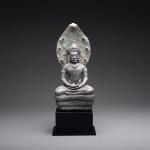Khmer Buddha Meditating on Naga, 12th Century CE - 13th Century CE
Bronze
height 21.6 cm
height 8 1/2 in
height 8 1/2 in
FZ.412
Further images
The Khmer civilization, today embodied by the temples and ruins of Angkor, one of mankind's most astonishing and enduring architectural achievements, flourished from 802-1431 A.D. From the great citadel of...
The Khmer civilization, today embodied by the temples and ruins of Angkor, one of mankind's most astonishing and enduring architectural achievements, flourished from 802-1431 A.D. From the great citadel of Angkor, the kings of the Khmer empire ruled over a vast domain that reached from what is now southern Vietnam to Yunan, China and from Vietnam westward to the Bay of Bengal. The original city was built around the Phnom Bakeng, a temple on a hill symbolizing the mountain that stands in the center of the world according to Hindu cosmology. Successive kings enlarged the city, building other temples devoted to various Hindu deities and large reservoirs used for irrigation, which also symbolized the ocean surrounding the holy central mountain.
During the twelfth century, the image of the Buddha meditating on Naga, the mythical sea serpent, became the most important Mahayana Buddhist cult image in Cambodia. He is traditionally represented in the meditation posture, seated upon the three-coiled throne of Naga’s body. Naga’s hood rises from behind the Buddha, spreading his seven heads outwards resembling the shape of a tree. Indeed, this image recalls the traditional Indian iconography of the Buddha under the Tree of Enlightenment. Typical of the Angkor period, the Buddha is depicted adorned in the sumptuous regalia reserved for Khmer royalty. A jeweled diadem crowns his head. His hair elegantly styled in a conical coiffure that also serves as his . Furthermore, he wears armbands and bracelets, a necklace and heavy earrings. By relating him to the royal elite, the artist imbues the Buddha with the powers associated with the King. In his hands, he holds a mysterious object. A lotus bud? A jewel? An alms bowl? Sometimes, this object is interpreted as a medicinal flask, leading this type of work to be identified as the “master of remedies.” This identification, although speculative, suggests the inherent power of this work to heal, to cure the sick, to soothe the suffering of humanity.
During the twelfth century, the image of the Buddha meditating on Naga, the mythical sea serpent, became the most important Mahayana Buddhist cult image in Cambodia. He is traditionally represented in the meditation posture, seated upon the three-coiled throne of Naga’s body. Naga’s hood rises from behind the Buddha, spreading his seven heads outwards resembling the shape of a tree. Indeed, this image recalls the traditional Indian iconography of the Buddha under the Tree of Enlightenment. Typical of the Angkor period, the Buddha is depicted adorned in the sumptuous regalia reserved for Khmer royalty. A jeweled diadem crowns his head. His hair elegantly styled in a conical coiffure that also serves as his . Furthermore, he wears armbands and bracelets, a necklace and heavy earrings. By relating him to the royal elite, the artist imbues the Buddha with the powers associated with the King. In his hands, he holds a mysterious object. A lotus bud? A jewel? An alms bowl? Sometimes, this object is interpreted as a medicinal flask, leading this type of work to be identified as the “master of remedies.” This identification, although speculative, suggests the inherent power of this work to heal, to cure the sick, to soothe the suffering of humanity.







